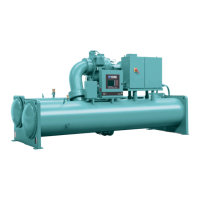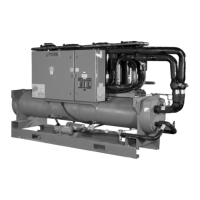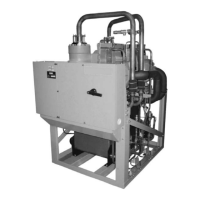Motor
The compressor motor is a hermetic permanent magnet high speed design with magnetic
bearings. The compressor impeller is overhung from the end of the motor shaft and has no
bearings of its own.
The motor includes angular contact ball bearings only engaged with the rotor shaft during
shutdown after rotation is stopped or during shutdown due to loss of power to the magnetic
bearings.
The bearing control center maintains correct shaft position in the magnetic bearings.
Heat exchangers
Evaporator and condenser shells are fabricated from rolled carbon steel plates with fusion welded
seams. Heat exchanger tubes are internally enhanced type.
Evaporator
The evaporator is a shell and tube, hybrid falling film, and flooded type heat exchanger. A
distributor trough provides uniform distribution of refrigerant over tubes in the falling film section.
Residual refrigerant floods the tubes in the lower section. Suction baffles are located above the
tube bundle to prevent liquid refrigerant carryover into the compressor. A 2 in. (51 mm) liquid level
sight glass is located on the side of the shell. The evaporator shell contains dual refrigerant relief
valves unless condenser isolation is installed.
Condenser
The condenser is a shell and tube type, with a discharge gas baffle to prevent direct high
velocity impingement on the tubes. A separate subcooler is located in the condenser to enhance
performance. Dual refrigerant relief valves are located on condenser shells and optional refrigerant
isolation valves are available.
Waterboxes
The removable compact waterboxes are fabricated of steel. The design working pressure is 150
psig (1,034 kPa) and the boxes are tested at 225 psig (1551 kPa). Integral steel water baffles provide
the required pass arrangements. Stub-out water nozzle connections with Victaulic grooves are
welded to the waterboxes. These nozzle connections are suitable for Victaulic couplings, welding
or flanges, and are capped for shipment. Plugged 3/4 in. (19 mm) drain and vent connections are
provided in each waterbox, except for marine waterboxes with vertical nozzles where there are
drain connections only. Optional marine waterboxes and higher pressure ratings are available.
Refrigerant flow control
Refrigerant flow to the evaporator is controlled by the liquid level control valve.
A level sensor senses the refrigerant level in the condenser and outputs an analog voltage to the
control panel that represents this level (0% = empty, 100% = full). Under program control, the
control panel modulates the liquid level control valve to control the condenser refrigerant level
to a programmed setpoint. Other setpoints affect the control sensitivity and response. Only a
qualified service technician can modify these settings. The level setpoint must be entered at chiller
commissioning by a qualified service technician.
While the chiller is shut down, the level control valve is pre-positioned to anticipate run. When
the chiller is started, if the actual level is less than the level setpoint, a linearly increasing ramp is
applied to the level setpoint. This ramp causes the setpoint to go from the initial refrigerant level
to the programmed setpoint over a programmable period of time. If the actual level is greater than
the setpoint upon run, it immediately begins to control to the programmed setpoint.
While the chiller is running, the refrigerant level is normally controlled to the level setpoint.
13
YMC
2
Mod B with OptiView Control Center

